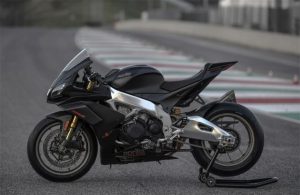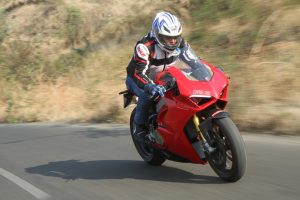BMW is finally set to launch the new BMW S 1000 RR in India and we are eagerly awaiting its imminent arrival. The BMW S 1000 RR, as we know, is one of the most powerful litre-class superbikes that one can buy. But this isn’t the only bike vying for the top spot.
What is the purpose of a superbike, if it doesn’t have a competitor? Where’s the fun right. So, the BMW S 1000 RR get its competition from the likes of Aprilia RSV4 and the Ducati Panigale among others, both of which are equally powerful and capable bikes.
So let’s spread the spec sheets of these bikes and try to get a comparative insight.
Performance:
| Bikes | Aprilia RSV4 | BMW S 1000 RR | Ducati Panigale V4 |
| Engine capacity (cc) | 999.6 cc | 999 cc | 1103 cc |
| Engine Layout | liquid-cooled, V4 | liquid-cooled, inline 4 | liquid-cooled, V4 |
| Peak Power (PS) | 201 PS @ 13,000 Rpm | 199 PS @ 13,500 Rpm | 214 PS @ 13,000 Rpm |
| Peak Torque (Nm) | 115 Nm @ 10,500 Rpm | 113 Nm @ 10,500 Rpm | 124 Nm @ 10,000 Rpm |
Clearly, the Ducati Panigale V4 has the biggest displacement engine among the three bikes, followed by the Aprilia RSV4 and then the BMW S 1000 RR. Ducati’s higher displacemnet engine enables the bike to produce more peak power and peak torque and the BMW S 1000 RR ranks the last due to its lesser displacement engine out of the lot. Out of these only the S 1000 RR offers an inline 4-cylinder engine, and the rest two offers the same V4 engine layouts. All the three bikes are liquid cooled.
Dimensions:
| Bikes | Aprilia RSV4 | BMW S 1000 RR | Ducati Panigale V4 |
| Fuel Tank Capacity (litres) | 18.5 litres | 17.5 litres | 16 litres |
| Tyre Size (Front) | 120/70 ZR 17 | 120/70 ZR 17 | 120/70 ZR 17 |
| Tyre Size (Rear) | 200/55 ZR 17 | 190/55 17 ZR 17 | 200/60 ZR 17 |
| Kerb Weight (Kg) | 180 Kg | 197 Kg | 198 Kg |
| Wheelbase (mm) | 1,420 mm | 1,441 mm | 1,469 mm |
Out of this lot of superbikes, the Ducati Panigale V4 has one major difference. The bike features a 60 profile rear tyre; a rarity on a road-going sport bike, although these taller, 60-profile tyres have been used in racing for some time now. Other than this, all the three bikes are dimensionally similar, with some minor differences here and there. But, if one had to choose any one of these bikes to take on the highway, the Aprilia RSV4 might be a better option, which offers the maximum fuel tank capacity, and hence a better range.
Chassis:
| Bikes | Aprilia RSV4 | BMW S 1000 RR | Ducati Panigale V4 |
| Frame | Aluminium dual beam frame | Aluminum composite bridge frame | Aluminium alloy monocoque |
| Front Suspension | Sachs 43-mm USD forks | Marzocchi 45-mm USD forks | Showa 43-mm USD forks |
| Rear Suspension | TTX Monoshock | Sachs Monoshock | Sachs Monoshock |
| Front Brakes | Brembo 320-mm dual discs | Hayes 320-mm dual discs | Brembo 330-mm dual discs |
| Rear Brakes | 220-mm disc | 220-mm disc | 245-mm disc |
The three bikes are equally competent on the track. Major credit goes to the strong biting power of the Brembo discs offered on the Ducati and the Aprilia, whereas the BMW get its stopping power via a set of brakes from Hayes, which they believe offers the smoothest initial bite. Suspension setup on the Aprilia comes from Sachs at the front and a TTX monoshock at the rear, whereas the BMW gets a set of Marzocchi USD fork and a monoshock unit from Sachs. The Ducati runs on a combination of suspension from Showa at the front and a set of Sachs at the back. These elements come together to make the bikes agile and stable, even at stratospheric speeds.
Price:
These three bikes are categorised as superbikes, and hence are super-pricey. The Ducati Panigale V4 is priced at Rs 22.70 lakh for the standard variant. On the other hand the Aprilia RSV4 costs a littlee less than the Ducati, priced at Rs 22.29 lakh. BMW have not revealed the price details for the S 1000 RR yet, and we expect it to be priced higher than the previous generation S 1000 RR, which had a tag of 18.05 lakh. We will know more on this count once the 2019 BMW S 1000 RR is launched in India, howevernwe expect it to be positioned in the Rs 20-lakh ballpark.
Conclusion:
All the three bikes are great track machines, yet with subtle differences of their own. Ultimately, the choice lies upon the rider to pick a bike among these three, and it may entirely depend upon the rider’s style of riding or simply their brand loyalty. What we do know is that these bikes are engineered to enthrall anyone who rides them.
Also read the ride review of the BMW S 1000 RR by our editor here.
Story: Koustubh Mukherjee





Leave a Reply